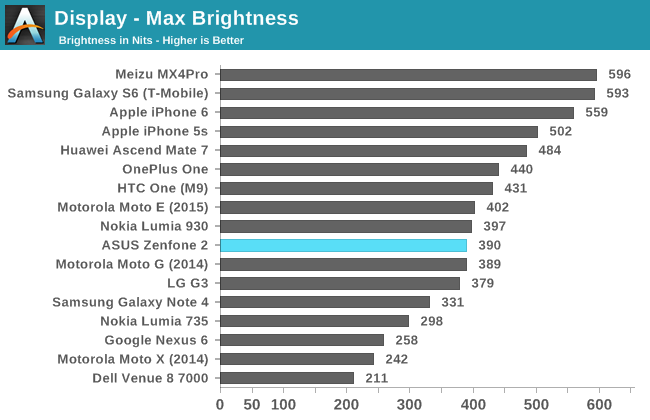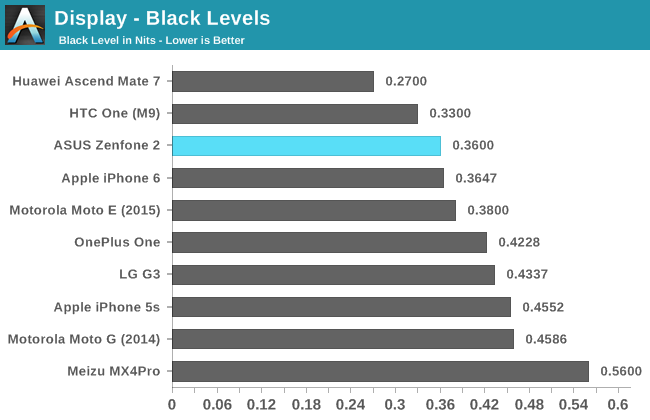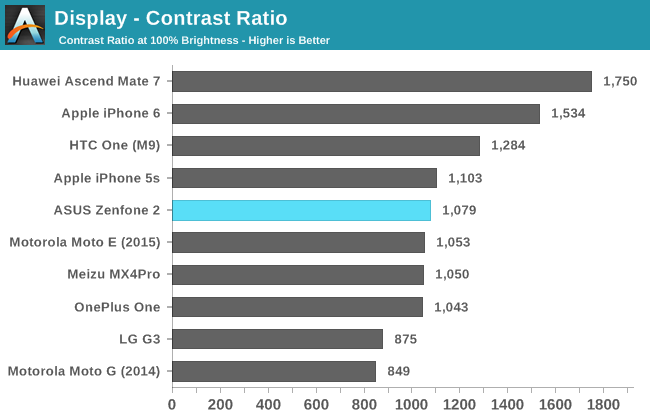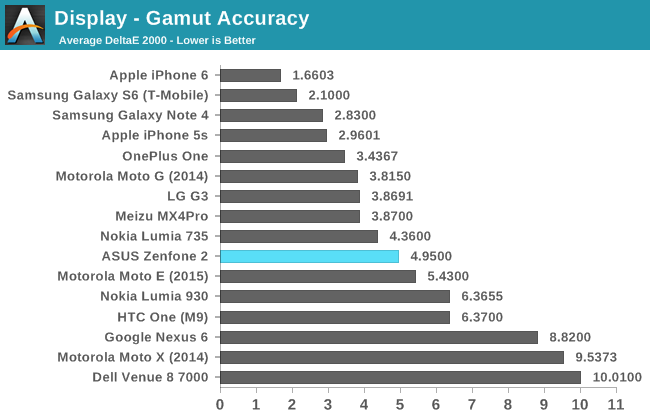The ASUS ZenFone 2 Preview
by Brandon Chester on May 18, 2015 2:00 PM ESTDisplay
I thought it would be important to give potential buyers some idea of how good the display is on the ZenFone 2. On paper it looks very good, as it's a 5.5" 1920x1080 IPS display. The pixel density isn't as high as the latest generation of 2560x1440 panels, but I find that with an RGB stripe panel the difference between 1920x1080 and 2560x1440 is minimal even at 5.5".


The ZenFone 2 appears to be off to a good start. Black levels are very low among our LCDs, and the max brightness is somewhat low but not terrible by any means. I never had any issues when using the ZenFone 2 outside, although it was definitely not as comfortable as the Galaxy S6.

The slightly low max brightness and above average black level results put the ZenFone 2 right in the middle of our LCD devices when it comes to contrast ratio.
Unfortunately, these numbers are somewhat misleading. This is because the ZenFone 2 makes extremely heavy use of dynamic contrast and contect adaptive backlighting. I have never used another device with such dramatic shifts in backlight power. The best example I've found is when switching from an all black to all white screen at max brightness. While this is obviously an extreme case, it illustrates the behavior that is occuring very well. At the moment you switch to white, the brightness of the display is around 170 nits. Over the next few seconds, that brightness rapidly increases to the 390 nits you see in the results above. This is an enormous jump in brightness, and it's very easy to see with your own eyes.
One last thing I'd like to note about the brightness is that the 100% setting on the built in brightness slider is not actually the max brightness that the display is capable of. The max you can achieve using the slider in the Settings app is 319 nits, which is around 82% of the 390 nit result you can get using applications like Brightness Adjuster from Google Play.

The gamut results are unfortunately not as good as what we've seen from the latest generation of smartphones. The DeltaE for red, blue, and magenta are all just over three, while the remaining three colors are around five. The high error in white also contributes to the higher than optimal overall error.
The complete review of the ZenFone 2 should be posted in the near future, and it will include the remainder of our display workflow. The heavy use of CABC and dynamic contrast has a large impact on the display's performance in some of our tests, and so I'll also be elaborating on where and why that occurs, and what it means for the user. For anyone who really wants to order the ZenFone 2 now, I'll conclude by saying that it's definitely not perfect, but it's still a good display. I think it's by far the nicest one you'll find on a phone that starts at $199 purely because of its resolution.











139 Comments
View All Comments
WorldWithoutMadness - Tuesday, May 19, 2015 - link
It's kinda funny that your standard became 5.1" under.It used to be in the range of 4"-4.5". Well, not to blame anyone though because I'm here waiting for something with google stock ROM and with 4.7" size.
kleos44 - Tuesday, May 19, 2015 - link
Yeah, but the screen size is not the important factor in how easy these things are to hold. The bezel sizes and thickness have all gotten smaller since the days when I thought a 4.3 to 4.5 inch phone would be perfect. The 5.1 inch Samsung S6 is as easy to hold as my HTC One M7 at 4.7 inches. Granted, I wish mine was slightly smaller and I am also hoping for a 4.7 inch close-to-stock android to come out with smaller bezels. Oddly enough the Galaxy Alpha is almost such a phone (and is reasonably priced these days) but I really hate Samsung's UI on it. It is smaller than both the Moto's mentioned below.Badelhas - Tuesday, May 19, 2015 - link
I tottaly agree. The Moto G 2013 and the Moto E 2015 (4,5 inch) are the perfect size in terms of ergonomics, in my opinion. I have a HTC One M8 (5 inch) and it´s a bit too bit for one hand use, and I have big hands.frag85 - Wednesday, May 27, 2015 - link
The 4.7" on my 1st Gen MotoX is more than large enough. I haven't upgraded because all the new phones from most manufacturers are way too large. Its a phone. If I wanted a tablet, I'd buy one.jann5s - Monday, May 18, 2015 - link
this is an interesting development, I truly hope that phones do get cheaper in general (i.e. midrange phones get better). Everything hinges on the battery life I guess, can't wait for the follow-up.Impulses - Monday, May 18, 2015 - link
For a while there it looked like they would... Between the Nexus 4 & 5, the OnePlus One and the price slashing on the first Moto X... The latter went larger and more upmarket tho, as did the Nexus. I was actually about to switch to a contract-less plan but I just realized it isn't worth it just to save $11/mo.jann5s - Monday, May 18, 2015 - link
On a side note, is it true x84, so you can put regular windows on it?DCide - Monday, May 18, 2015 - link
Yes, of course it's a true x83. It runs regular Windows, just like Microsoft phones.Ryan Smith - Monday, May 18, 2015 - link
It's x86, but it doesn't have the BIOS and other functionality required to run desktop Windows. Moorefield is meant to run phone OSes like Windows Phone and Android.DCide - Monday, May 18, 2015 - link
Thanks Ryan - you put me to shame. I should've answered straight.